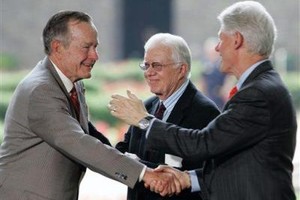When the 2028 Campaign Gets a Very Early Start

For those who are less than excited by the upcoming eighteen months of uninterrupted discussion of Joe Biden’s age and Donald Trump’s court calendar, it may or may not be helpful to know that the 2028 presidential campaign is already underway. But what the two most prominent combatants in the extremely early stages of the next election cycle lack in timeliness and patience, they make up for in anger and mutual contempt.
Neither Ron DeSantis nor Gavin Newsom would be upset if they were able to take up residency in the White House in January of 2025 rather than waiting for another four years. But decorum requires Newsom to wait until Biden has concluded his presidency, and barring an unexpected health matter, the California governor will spend this election cycle vigorously campaigning for Biden while emphasizing how much more energetic and combative he is than the current president. Because Trump is no longer in office, DeSantis is not waiting to mount his own campaign, but his chances for victory appear small at the moment, so it’s likely that he will be a second-time candidate four years from now.
But neither Newsom nor DeSantis feels compelled to wait until the current campaign has concluded before beginning the next one. Already, the two Sunbelt governors have been exchanging small arms fire for the last several months, each pointing to the other as to all that’s wrong with American politics and state governance.
This transcontinental rivalry began to pick up steam during the coronavirus pandemic, when Florida and California’s leaders pursued diametrically opposite paths in how they handled the shutdown and reopening of their respective states. DeSantis pushed hard for stores and schools to reopen as quickly as possible, and then touted the economic and educational benefits of his more aggressive approach. Newsom moved much more cautiously and emphasized the health benefits to his constituents of moving more gradually.
It’s debatable that COVID policy will play much of a role in the 2024 election debate, let alone four years further into the future. But the stark contrast between the two men’s strategies lit a fire under both of them and has fostered a rivalry that has continued to escalate over the last couple of years. What started out as occasional tweets or offhand references on cable television has since mushroomed into a much more heated and heightened rivalry, in which both Newsom and DeSantis have sought out highly visible opportunities to score political points at the expense of the other.
Their rivalry reached a new level of vitriol earlier this year when both men invaded each other’s turf to castigate the other from close range. Newsom traveled to Florida this spring to meet with students at the New College of Florida, which had turned into a battleground in the nation’s cultural war after DeSantis named several conservative trustees of a previously liberal academic institution. Newsom accused his fellow governor of “bullying and intimidating vulnerable communities” and attacked DeSantis’ plan as “weakness masquerading as strength”. This was just a few weeks after DeSantis spoke at the Ronald Reagan Presidential Library, where he delivered a scathing denunciation of California’s “woke ideology” and excoriated “lockdown politicians” such as Newsom.
In the last couple of weeks, the two governors have intensified their feud even further. DeSantis sent two planeloads of undocumented migrants to Sacramento, repeating a stunt he had pulled last year when his office arranged for a similar group of immigrants to be transported to Massachusetts. Since then, Newsom has called for an amendment to the U.S. Constitution requiring stricter gun control and used an extended interview on Fox News to agree to a debate with DeSantis moderated by Fox host Sean Hannity.
Most telling about this next generation of political warfare is the content of the arguments between the two men. Neither demonstrates nearly as much interest in discussing economic and housing policy as their continued focus on social and cultural issues. Newsom tends to emphasize abortion rights, same-sex marriage, and gun control, while DeSantis spends most of his time on crime, immigration, and school curriculum.
Both recognize that these are the topics that are most exciting to their parties’ respective bases, and so both devote much of their firepower to motivating their true believers. There will be plenty of time for swing voters five years from now, when the two of them will face off for real. In the meantime, this long-distance shadowboxing effectively serves both of their interests.
Want to talk about this topic more? Join Dan for his webinar "Politics In The Time of Coronavirus." Or read more of Dan’s writing at: www.danschnurpolitics.com.
Dan Schnur is a Professor at the University of California – Berkeley, Pepperdine University, and the University of Southern California, where he teaches courses in politics, communications and leadership. Dan is a No Party Preference voter, but previously worked on four presidential and three gubernatorial campaigns, serving as the national Director of Communications for the 2000 presidential campaign of U.S. Senator John McCain and the chief media spokesman for California Governor Pete Wilson. He has a Center bias.
This piece was reviewed and edited by Isaiah Anthony, Deputy Blog Editor (Center bias).

May 30th, 2024

May 29th, 2024

May 28th, 2024
May 23rd, 2024